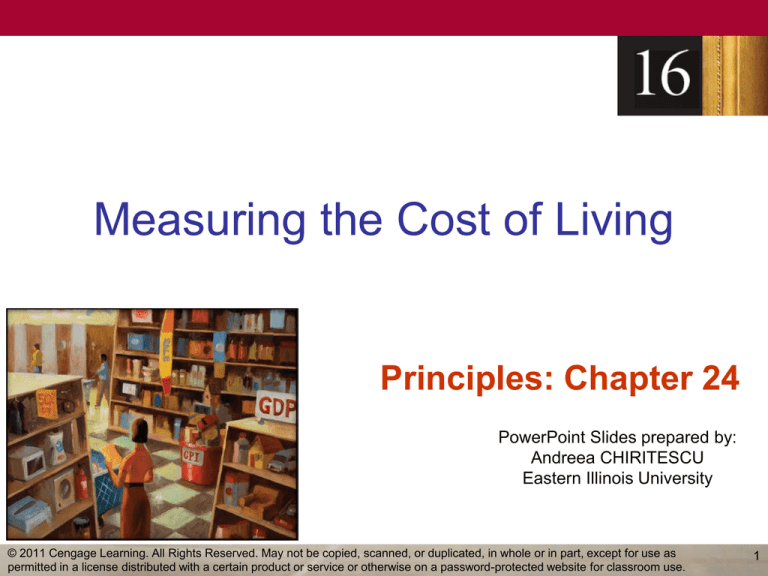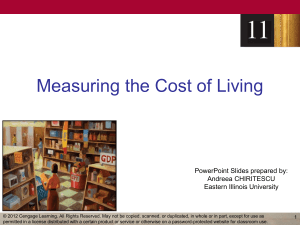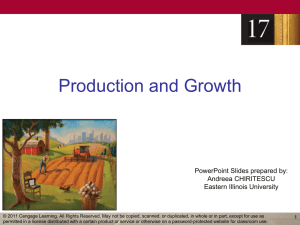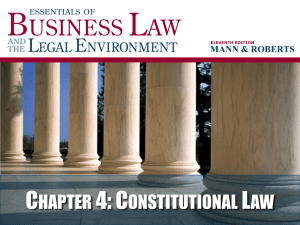
Measuring the Cost of Living
Principles: Chapter 24
PowerPoint Slides prepared by:
Andreea CHIRITESCU
Eastern Illinois University
© 2011 Cengage Learning. All Rights Reserved. May not be copied, scanned, or duplicated, in whole or in part, except for use as
permitted in a license distributed with a certain product or service or otherwise on a password-protected website for classroom use.
1
The Consumer Price Index
• Consumer price index (CPI)
– Measure of the cost of living
– For a typical consumer
– Reported monthly by the Bureau of Labor
Statistics
• Track price changes for on a fixed basket of
goods and services
© 2011 Cengage Learning. All Rights Reserved. May not be copied, scanned, or duplicated, in whole or in part, except for use as
permitted in a license distributed with a certain product or service or otherwise on a password-protected website for classroom use.
2
Calculating CPI
4. Chose a base year and compute the CPI
– Base year = benchmark
• Price of basket of goods & services in current
year
• Divided by price of basket in base year
• Times 100
5. Compute the inflation rate
CPI in year 2 - CPI in year 1
Inflation rate in year 2
100
CPI in year 1
© 2011 Cengage Learning. All Rights Reserved. May not be copied, scanned, or duplicated, in whole or in part, except for use as
permitted in a license distributed with a certain product or service or otherwise on a password-protected website for classroom use.
3
Figure 1
The Typical Basket of Goods and Services
This figure shows how
the typical consumer
divides spending
among various
categories of goods
and services. The
Bureau of Labor
Statistics calls each
percentage the “relative
importance” of the
category.
© 2011 Cengage Learning. All Rights Reserved. May not be copied, scanned, or duplicated, in whole or in part, except for use as
permitted in a license distributed with a certain product or service or otherwise on a password-protected website for classroom use.
4
The Consumer Price Index
• Problems in measuring the cost of living
– Substitution bias
• Prices do not change proportionately
• Consumers substitute toward goods that
have become relatively less expensive
– Introduction of new goods
• More variety of goods
– Unmeasured quality change
• Changes in quality
© 2011 Cengage Learning. All Rights Reserved. May not be copied, scanned, or duplicated, in whole or in part, except for use as
permitted in a license distributed with a certain product or service or otherwise on a password-protected website for classroom use.
5
Figure 2
Two Measures of Inflation
This figure shows the inflation rate—the percentage change in the level of prices— as
measured by the GDP deflator and the consumer price index using annual data since 1965.
Notice that the two measures of inflation generally move together.
© 2011 Cengage Learning. All Rights Reserved. May not be copied, scanned, or duplicated, in whole or in part, except for use as
permitted in a license distributed with a certain product or service or otherwise on a password-protected website for classroom use.
6
Correcting Economic Variables
• Dollar figures from different times
Amount in today's dollars
Price level today
Amount in year T dollars
Price level in year T
• Indexation
– Automatic correction by law or contract of
a dollar amount for the effects of inflation
– Social Security benefits
© 2011 Cengage Learning. All Rights Reserved. May not be copied, scanned, or duplicated, in whole or in part, except for use as
permitted in a license distributed with a certain product or service or otherwise on a password-protected website for classroom use.
7
Real and Nominal Interest Rates
• Nominal interest rate
– Interest rate as usually reported
– Without a correction for the effects of
inflation
• Real interest rate
– Interest rate corrected for the effects of
inflation
= Nominal interest rate – Inflation rate
© 2011 Cengage Learning. All Rights Reserved. May not be copied, scanned, or duplicated, in whole or in part, except for use as
permitted in a license distributed with a certain product or service or otherwise on a password-protected website for classroom use.
8
Interest rates in the U.S. Economy
• Nominal interest rate
– Almost always exceeds the real interest
rate
– U.S. economy has experienced rising
consumer prices in every year
– Real interest rate exceeds the nominal
interest rate in periods of deflation
© 2011 Cengage Learning. All Rights Reserved. May not be copied, scanned, or duplicated, in whole or in part, except for use as
permitted in a license distributed with a certain product or service or otherwise on a password-protected website for classroom use.
9
Figure 3
Real and Nominal Interest Rates
This figure shows nominal and real interest rates using annual data since 1965. The nominal
interest rate is the rate on a 3-month Treasury bill. The real interest rate is the nominal interest
rate minus the inflation rate as measured by the consumer price index. Notice that nominal and
real interest rates often do not move together.
© 2011 Cengage Learning. All Rights Reserved. May not be copied, scanned, or duplicated, in whole or in part, except for use as
permitted in a license distributed with a certain product or service or otherwise on a password-protected website for classroom use.
10












